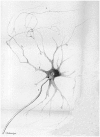Grey Matter Etymology and the neuron(e)
- PMID: 31844876
- PMCID: PMC6935745
- DOI: 10.1093/brain/awz367
Grey Matter Etymology and the neuron(e)
Erratum in
-
Erratum.Brain. 2020 Mar 1;143(3):e24. doi: 10.1093/brain/awaa007. Brain. 2020. PMID: 32333675 Free PMC article. No abstract available.
Abstract
‘Neuron’ or ‘neurone’? While it is often assumed that these different spellings reflect usage of American versus British English, there are also inconsistencies within these cultural boundaries. Mehta et al. review historical, etymological and linguistic evidence concerning the spelling of ‘neuron(e)’ and conclude that the only correct spelling is ‘neuron’.
Figures




Comment in
-
The etymology of 'neurology', redux: early use of the term by Jean Riolan the Younger (1610).Brain. 2021 May 7;144(4):e38. doi: 10.1093/brain/awab023. Brain. 2021. PMID: 33837748 No abstract available.
-
Reply: The etymology of 'neurology', redux: early use of the term by Jean Riolan the Younger (1610).Brain. 2021 May 7;144(4):e39. doi: 10.1093/brain/awab024. Brain. 2021. PMID: 33837768 Free PMC article. No abstract available.
References
-
- Barker L. Concerning neurological nomenclature. Bull Johns Hopkins Hosp 1896; 7: 201.
-
- Barker LF. The nervous system and its constituent neurones: designed for the use of practitioners of medicine and of students of medicine and psychology. New York: D. Appleton and Company; 1899.
-
- Deiters O. Untersuchungen über Gehirn and Rückenmark des Menschen und der Säugetiere. Braunschweig: Vieweg & Sohn; 1865.
-
- Foster M. (with Sherrington CS). The central nervous system and its instruments. In: A Text Book of Physiology. London, Macmillan; 1897.

